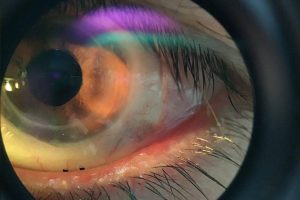Normal pupils are usually 4-6 mm in diameter in room lighting. With miosis, the pupils are less than 2mm.
Your pupil is the dark circle in the center of your eye. It grows and shrinks thousands of times per day. It enlarges to let in more light while you’re in dim light and shrinks to protect your eye and keep light out while you’re in bright light.
What is miosis?
Miosis is a condition where your pupil shrinks or constricts in size.
If your pupils remain small even in dim light, it could indicate that something in your eye isn’t operating properly. This condition is known as abnormal miosis, and it can affect one or both eyes.
There are many causes of pupils shrinking in size:
Age
It’s usual for a newborn’s pupils to remain small for roughly two weeks so that their eyes are shielded from strong light.
In old age, the pupils begin to shrink as well. The muscles that control the pupils can become weak, making it difficult to open them. It may be more difficult to see at night as a result.
Inflammation
Swelling inside the eye can make it difficult for the pupils to expand.
This can occur due to an eye injury or could also be due to a condition known as uveitis, which causes swelling in the iris and the tissues around it.
Medication and narcotics
Miosis can also be caused by medication side effects.
Certain medications for anxiety, muscle spasms and seizures, such as diazepam (Valium) and antihistamines like diphenhydramine (Benadryl), can cause the pupils to shrink.
Narcotics, whether prescribed or illicit, can do the same.
Some of the commonly used drugs that can cause miosis are these opioids;
- fentanyl
- oxycodone
- codeine
- heroin
- morphine
- methadone
Contact an eye doctor near you to find out why your pupils may be small.
SEE RELATED: Eye Health
Genes
Congenital miosis or microcoria is an inherited condition where the muscle that regulates the pupils or your pupil muscles aren’t properly formed.
When one or both of your parents pass on an inherited defective gene, this can affect either one or both eyes.
You may be nearsighted and have difficulty seeing objects far away if you have it. You could also develop glaucoma, which implies there is too much pressure in your eyeball.
Horner’s syndrome
The way your brain ‘talks’ to one side of your face, including one of your eyes, is affected by this rare condition.
Horner’s syndrome has the potential to cause one pupil to be smaller than the other and can be inherited or develop after a neck injury or surgery.
It can also result from chest, neck and brain malformations and a rare type of cancer called neuroblastoma, or a tumor in another part of the body.
Other causes
Other causes of miosis may include:
- Severe lack of vitamin D
- Neurosyphilis (a bacterial infection in your brain that comes from untreated syphilis)
Treatment of miosis
The treatment will be based on the cause of your abnormal miosis. If a medication is causing it, you may be prescribed an alternative.
If eye inflammation is the culprit, your eye doctor may prescribe long-lasting dilating drops (atropine or homatropine) to widen your pupils. These are similar to the dilation drops your optometrist uses during an eye exam, but they can last up to two weeks.
If Horner’s syndrome is to blame, various tests may be required to determine the best course of action.
LEARN MORE: Guide to Eye Health
If you notice you have small pupils, schedule an appointment with an eye doctor near you to discuss treatment options.


